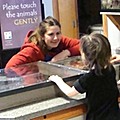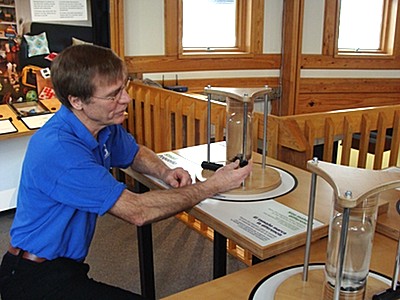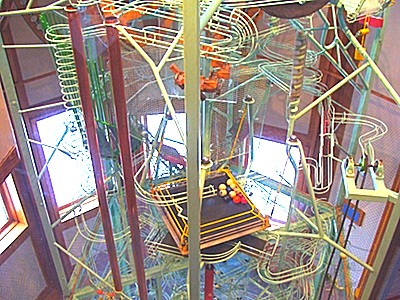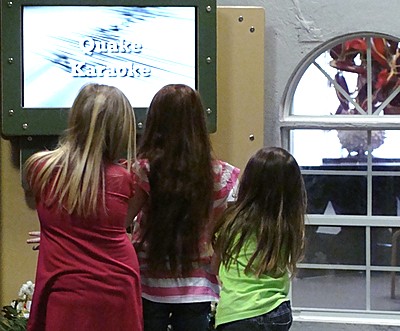- By Dan Veaner
- Around Town
 Print
Print  Last weekend The Ithaca Sciencenter began celebrating its 30th anniversary. The Sciencenter has come a long way in those three decades, morphing from a volunteer-run organization with portable exhibits to a full fledged museum that not only creates its own exhibits, but sends them to other museums as well.
Last weekend The Ithaca Sciencenter began celebrating its 30th anniversary. The Sciencenter has come a long way in those three decades, morphing from a volunteer-run organization with portable exhibits to a full fledged museum that not only creates its own exhibits, but sends them to other museums as well. "We're trying to inspire kids. We take that very seriously," says Sciencenter Executive Director Charlie Trautmann. "We can do what the schools can't. We don't necessarily have to teach them how to do the science. We provide the props -- our exhibits -- for kids to learn and families to talk to each other about."
Now that the museum has been built out in three phases Trautmann says it will change direction in order to expand its audience. Until now the Sciencenter has targeted kids of elementary school age. Starting this year it will serve kids from birth through middle school age.
"A lot of the things we're talking about have been piloted. We know they work," he says. "We want to scale them up a bit. The early childhood programs are really new. The middle school work has been at a low level, so it will be an expansion. For the middle group we have served all along, we'll have new exhibitions. Some of our exhibits are 20 years old now. We want to rennovate the really good ones and replace what's not so good. There will be a facelift to the museum itself. It will take around three years to get it up and rolling."
 It's A Nano World -- Executive Director Charlie Trautmann explores tiny, tiny particles
It's A Nano World -- Executive Director Charlie Trautmann explores tiny, tiny particlesWhile the new initiatives will include hands-on exhibits for younger children, the museum plans to reach out into the community to serve middle schoolers. They will be involved in community research projects, volunteering at the museum to teach science to other kids, leadership development, and field trips to see what science is like in the corporate world and to see what environmentalists are doing across the state. The museum will also provide resources to middle school science clubs.
The Sciencenter was founded on February 28, 1983. It was entirely run by volunteers until 1990, when current site, formally a sewage treatment plant, was obtained and Trautmann was hired. 2,200 people helped turn the original building into a museum. Phase 1 of the new facility opened May 23, 1993. A second phase involved rehabilitating another building on the site in the late 1990s. Phase 3 opened on February 28th, 2003. That pulled the two buildings together and added an auditorium, spacious exhibit space, and a new entry.
 Quantum's Last Leap
Quantum's Last LeapCentral to the museum is 'Quantum's Last Leap', a dynamic two-story sculpture on which balls travel along tracks, designed by George Rhodes and built by Bob Maguire. Notably Tom Rockwell, the artist Norman Rockwell's grandson, helped procure art and designed the playground for the Sciencenter. The museum includes a live animals room featuring reptiles from around the world, and plans to open an exhibit of local reptiles and fish in 2014.
The Sciencenter builds many of its own exhibits, some of which travel to other museums. 'It's a Nano World' was developed at the Ithaca museum, and is being duplicated by The Science Museum of Minnesota. Currently 49 copies are on display around the country. Eventually the exhibit will be on display in 70 museums. Trautmann says the Sciencenter is the only museum to have exhibits travel to Epcot. 'It's a Nano World' visited the Disney park in 2004, and 'Zoom Into Nano' was displayed there in 2007.
The museum has about 2500 paying family members, and about 300 families who qualify for free memberships under a membership access program. The Sciencenter has had about 100,000 visitors per year for the past ten years. Trautmann notes that is pretty good for a museum in a county with a population of around 102,000.
 Kids learn what an earthquake feels like
Kids learn what an earthquake feels likeEvery few years the Sciencenter surveys high school seniors, asking three questions to determine how well the Sciencenter is fulfilling its mission.
About 400 Ithaca High School students, plus all Newfield, Trumansburg, Lansing and Dryden seniors are surveyed. Trautmann says results from year to year are consistant. Between 95 and 98 percent of seniors remember their childhood visits to the Sciencenter as fun. About two thirds say they have a better attitude about science because of their experiences at the museum. 40% say their experiences at the Sciencenter influenced them to study science further.
"That's pretty good. Any board of trustees would be delighted to say that 40% of our target audience is saying we had an impact that we are looking for. We want to say 40% is great, but we want to do even better. We want to get more kids into careers in science, or using science in a career."
Trautmann says science literacy in America is dismal. He says that ways of teaching science in schools are geared to learning facts that students can be tested on. He says that approach turns kids off of science.

"The really important science is inquiry based, based on questions, learning how to learn, experimentation that takes equipment and time, and it's harder to test," he says. "So it's very difficult to do good science in our schools. We think of science as a process for learning about the world -- it's not a collection of facts."
That is where the Sciencenter comes in.
"Nobody flunks a science museum," he says. "They come to investigate."
Last weekend the museum was filled with kids enjoying special programs and demonstrations. A picture display showing the museum being built was enhabnced with a program about how science exhibits are designed and built. Special hands-on activities and touch tank hours ran throughout the two day celebration, which was intended to kick off a year of celebration. The atmosphere was loud, happy and jubilant as kids spread throughout the museum investigating and learning that science isn't just facts, but hands-on fun.
v9i9



